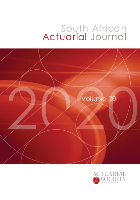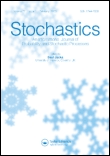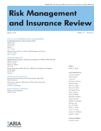
South African Actuarial Journal
Scope & Guideline
Transforming risk management with cutting-edge research.
Introduction
Aims and Scopes
- Actuarial Modeling and Analysis:
The journal focuses on developing and refining actuarial models, such as Markov Chain models, to analyze life expectancy and risk assessment in South Africa. - Healthcare Analytics:
A significant area of research involves applying advanced analytics in healthcare, exploring how data-driven approaches can enhance decision-making and risk management. - Regulatory Frameworks and Systemic Risk:
The journal examines the role of actuaries in contributing to systemic risk management and the implications for regulatory bodies, providing frameworks for better oversight. - Legal and Ethical Aspects of Actuarial Practice:
There is a focus on the intersection of actuarial practice with legal issues, including the role of actuaries as expert witnesses and the ethical considerations in their work. - Economic Impact Assessments:
Research often includes the economic implications of actuarial decisions, such as the effects of remittances on life insurance purchases and the significance of discount rates in damage calculations.
Trending and Emerging
- Integration of Advanced Analytics:
There is a growing emphasis on the use of advanced analytics, particularly in healthcare, indicating a trend towards leveraging big data and machine learning to inform actuarial practices. - Focus on Systemic Risk and Regulation:
Recent publications show an increasing interest in understanding the contribution of insurers to systemic risk, highlighting the need for actuaries to engage with regulatory frameworks and risk management strategies. - Personal Finance and Retirement Planning:
Emerging themes around quantitative guidelines for safer retirement and the implications of economic factors on personal finance reflect a rising concern for individual financial security and planning. - Legal and Ethical Dimensions of Actuarial Work:
There is an evident trend towards exploring the legal responsibilities and ethical dilemmas faced by actuaries, which is becoming a critical area of discussion in the context of professional standards and accountability.
Declining or Waning
- Historical Perspectives on Actuarial Science:
Research that delves into historical actuarial practices, such as the history and forecast of South African life tables, seems to have waned, possibly as the field shifts towards more contemporary applications. - Traditional Risk Assessment Methods:
The focus on conventional methods of risk assessment, such as basic actuarial calculations without advanced analytics, appears to be declining as the field embraces more sophisticated analytical techniques. - Generalized Economic Models:
There seems to be a reduction in the publication of generalized economic models that do not directly relate to specific South African contexts or emerging issues, indicating a shift towards more localized and relevant research.
Similar Journals

Stochastics-An International Journal of Probability and Stochastic Processes
Connecting Scholars Through Groundbreaking Stochastic InsightsStochastics: An International Journal of Probability and Stochastic Processes, published by Taylor & Francis Ltd, is a pivotal platform for the dissemination of innovative research in the realms of probability and stochastic processes. Since its inception in 1975, the journal has evolved to encapsulate a rich array of methodologies and applications, contributing significantly to the fields of modeling, simulation, and statistical analysis. With a current impact factor ranking in the Q3 category for both Modeling and Simulation and Statistics and Probability, it positions itself as a valuable resource for professionals, researchers, and students alike. The journal’s coverage spans a unique historical arc from 1975, and it continues to push boundaries up to 2024, ensuring the latest trends and discoveries are accessible to an engaged audience. Though not Open Access, the journal’s scholarly contributions are crucial for advancing understanding and innovation in stochastic modeling, making it an essential read for those seeking to deepen their expertise in the field.

Anales del Instituto de Actuarios Espanoles
Elevating the Standards of Actuarial Research and InnovationAnales del Instituto de Actuarios Españoles is a prestigious journal dedicated to advancing the field of actuarial science and related disciplines. Published by the Instituto de Actuarios Españoles, this journal serves as a vital platform for researchers, practitioners, and students aiming to share innovative methodologies, comprehensive analyses, and groundbreaking research that contribute to the actuarial profession. Although not an open-access journal, its rigorous peer-review process ensures high-quality publications that have garnered respect within the academic community. With an ISSN number of 0534-3232 and an E-ISSN of 2531-2308, Anales del Instituto de Actuarios Españoles plays a crucial role in disseminating knowledge that shapes actuarial practices and policies, thereby enhancing the effectiveness of the profession in addressing contemporary challenges.

Japanese Journal of Statistics and Data Science
Bridging Theory and Practice in Data ScienceJapanese Journal of Statistics and Data Science, published by SPRINGERNATURE, is a leading academic journal dedicated to the advancement of statistical methodologies and data science applications, with a focus on fostering innovative research and discourse within the field. Since its inception in 2018, the journal has sought to bridge theory and practice, embracing emerging trends and interdisciplinary approaches that contribute to the ever-evolving landscape of statistics, probability, and computational theory. Hailing from Germany, the journal holds an impressive Q3 ranking in both Computational Theory and Mathematics and Statistics and Probability, reflecting its commitment to high-quality, impactful research. With an accessible ISSN of 2520-8756 and E-ISSN 2520-8764, the journal invites a global audience of researchers, professionals, and students to explore its rich array of articles and findings, all aimed at furthering knowledge and application in the realm of data science.

Journal of Risk
Charting New Territories in Risk AnalysisJournal of Risk, published by INCISIVE MEDIA, serves as an essential platform for scholars and practitioners in the fields of finance and strategic management. With an ISSN of 1465-1211 and an E-ISSN of 1755-2842, this journal explores the multifaceted nature of risk, encompassing theoretical frameworks, empirical investigations, and practical applications. Although currently classified in Q4 for both Finance and Strategy and Management categories as per 2023 standards, it provides a crucial forum for innovative research and thought leadership, addressing the challenges faced in understanding and managing risk in today’s dynamic environment. The journal, based in the United States, is committed to advancing knowledge and offering a platform for debate and dialogue in its convergence years from 2011 to 2024. Researchers, professionals, and students are encouraged to contribute their insights to enhance the academic discourse surrounding risk management.

Journal of Risk Model Validation
Advancing Knowledge in Risk Modeling for Informed Decision-MakingJournal of Risk Model Validation, published by INCISIVE MEDIA, is a pivotal scholarly platform dedicated to the fields of Applied Mathematics, Economics, Econometrics, and Finance. With an ISSN of 1753-9579 and an E-ISSN of 1753-9587, this journal actively contributes to the advancement of knowledge through the rigorous validation of risk models, which is essential for informed decision-making in business and economic contexts. Although currently not an Open Access journal, it serves a vital role in the academic community, evidenced by its categorization in the Q4 and Q3 quartiles across various relevant fields. As of 2023, it holds commendable Scopus rankings, reflecting its relevance and engagement within the global academic discourse. The journal encourages submissions from a wide array of researchers, professionals, and students until 2024, fostering a comprehensive exploration of risk model methodologies and their practical applications. Emphasizing both theoretical frameworks and empirical studies, the Journal of Risk Model Validation is an essential resource for those dedicated to enhancing the reliability and effectiveness of risk assessment in contemporary finance and economics.

Connecticut Insurance Law Journal
Championing Excellence in Legal ScholarshipWelcome to the Connecticut Insurance Law Journal, an esteemed academic publication dedicated to advancing scholarship in the field of insurance law. Published by the University of Connecticut School of Law, this journal aims to provide a platform for researchers, practitioners, and students to explore contemporary issues and emerging trends in insurance legislation and policy. The journal, bearing the ISSN 1081-9436, offers a valuable resource for those invested in legal studies, featuring contributions from prominent scholars and professionals. While it does not operate under an Open Access model, readers can expect high-quality articles that delve deep into critical legal analyses, case studies, and discussions that shape insurance law practices today. As insurance law continues to evolve in response to economic and social changes, the Connecticut Insurance Law Journal is essential for those seeking to stay informed and engaged in this vital area of study.

Risks is an esteemed Open Access journal published by MDPI, based in Switzerland, dedicated to exploring multifaceted dimensions of risk across various fields, including Accounting, Economics, Finance, and Management. Since its inception in 2013, the journal has fostered academic discourse by providing a platform for high-quality research that addresses contemporary challenges and theoretical advancements within these disciplines. With a commendable ranking in the 75th percentile for Economics, Econometrics and Finance, and distinction in Accounting and Strategy Management, Risks maintains robust academic quality that resonates within the global research community. The journal not only prioritizes accessibility with its Open Access model but also aims to bridge the gap between academia and industry through rigorous peer-reviewed publications. Researchers, professionals, and students alike will find Risks to be an invaluable resource for innovative insights and evidence-based analyses in the field of risk management.

Mathematics and Financial Economics
Advancing Insights at the Intersection of Math and FinanceMathematics and Financial Economics, published by Springer Heidelberg, is a leading peer-reviewed journal that explores the intersections of mathematical theories and financial practices. With an ISSN of 1862-9679 and an E-ISSN of 1862-9660, the journal has made notable contributions to its field since its inception in 2007, with a convergence period extending until 2024. Positioned in the prestigious Q2 category for both Finance and Statistics and Probability, the journal is ranked within the top 66th percentile in Mathematics and Statistics and the 62nd percentile in Decision Sciences according to Scopus metrics. Researchers and professionals looking for high-quality, innovative research in mathematical finance will find valuable insights within its pages. Although primarily a subscription-based journal, it aims to foster knowledge sharing among academia and industry experts. Its commitment to advancing quantitative methods and financial applications solidifies its importance as a resource for students, researchers, and practitioners dedicated to understanding and navigating the complex dynamics of financial markets.

RISK MANAGEMENT AND INSURANCE REVIEW
Pioneering Research in Risk Assessment and Insurance PracticesRISK MANAGEMENT AND INSURANCE REVIEW, published by Wiley, is a vital journal for researchers and practitioners in the fields of accounting, economics, and finance. With an ISSN of 1098-1616 and an E-ISSN of 1540-6296, this journal serves as a comprehensive platform for the dissemination of cutting-edge research and insights into risk management and insurance practices. Although it does not offer an open-access model, it is recognized for its rigorous peer-review process and maintains an impactful presence within the academic community, reflected in its 2023 Scopus rankings in various disciplines, including its Q3 quartile status across multiple categories. The journal's scope addresses key contemporary issues in risk assessment, financial stability, and insurance innovation, contributing significantly to the evolving discourse in these areas. As it converges from 2006 to 2024, RISK MANAGEMENT AND INSURANCE REVIEW continues to attract a diverse readership, providing valuable resources and fostering dialogue among students, professionals, and established researchers alike.

Geneva Risk and Insurance Review
Unveiling innovative solutions in the insurance sector.Geneva Risk and Insurance Review, published by Palgrave Macmillan Ltd, stands as a premier academic journal dedicated to advancing the understanding of risk and insurance through rigorous research and analysis. With an ISSN of 1554-964X and an E-ISSN of 1554-9658, this journal has carved out a notable niche in the fields of Accounting, Business Management, and Finance, as reflected by its 2023 category quartiles and Scopus rankings, positioning it among the top echelons of scholarly output in these disciplines. The journal is renowned for its commitment to open access, enhancing accessibility for a diverse audience of researchers, professionals, and students keen to explore the complexities of risk dynamics. Since its inception in the mid-1970s, and with recent converged years leading up to 2024, it has consistently provided a platform for groundbreaking studies that shape policies and practices in the insurance sector. The journal's reputation for excellence and influential contributions makes it an essential resource for those engaged in the evolving discussions surrounding risk management and insurance strategies.